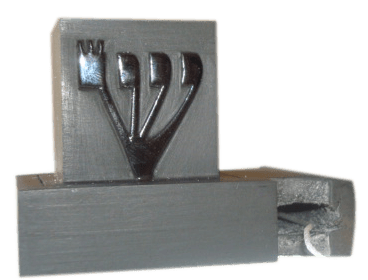The Torah says that the head tefillin should be “frontlets between your eyes” (Devarim 11:18). However, this expression does not mean actually between the eyes, for example the bridge of the nose. This is clear from a subsequent verse: “You are the children of HaShem your G-d; do not cut yourselves, nor make baldness between your eyes for the dead” (Devarim 14:1). The second half of the verse forbids a pagan mourning custom of tearing out the hair; it is clear that the identical expression “between your eyes” actually refers to the hair above the forehead. This is the ruling of the Shulchan Arukh (SA OC 27:9, based on Menachot 37b).
The significance of this placement seems clear. The gemara emphasizes that this is the “govah shebarosh”, “the height of the head”. The simplest meaning is that this is a commanding and elevated spot, unlike the eyes which are in the middle of the head. More symbolically, this part of the head represents a more elevated part of our humanity; the eyes represent our senses, which we share with the lower animals, but the forehead is adjacent to our brains, the seat of thought. (It is adjacent specifically to the “forebrain”, the most “advanced” part of the brain. Indeed, today this is considered the part where the human brain is most distinguished from that of other animals.)
This hierarchy is found elsewhere in the laws of tefillin. The very beginning of the laws of tefillin in the Shulchan Arukh explains that we should be careful to put on tzitzit before tefillin (SA OC 25 :1). The tzitzit represent censoring the senses and particularly the sense of sight, as the Torah explicitly tells us,”And it shall be to you for a fringe, that you should see it and remember all the commandments of HaShem and do them; and not turn after your heart and your eyes, after which you stray” (Bamidbar 15:39). Only afterwards do we sanctify our higher faculties. We have to take great care to preserve this order, because it is nearly impossible to sanctify our inner thoughts if we have not yet gained control of our gaze.
Even given this understanding of the placement of the tefillin, we need to ask why the Torah calls this place “between the eyes”. Why couldn’t the Torah simply state, “they shall be for frontlets above your brow”? It seems that the Torah is reminding us that our senses are ultimately subordinate to our thoughts. We shouldn’t”see” with our eyes; our eyes are responsible for collecting sense data, but our sight, our inner vision, is determined by our thoughts and our intellect. Our higher faculties are the seat not only of thought, but also of perception.
The first stage in self-sanctification is to filter our senses. This is represented by the fringes of the tallit, which draw our attention and distract us from the temptations of the outside world. But after we have reached this stage (not before!) we can attain a higher stage of actually sanctifying our senses, of subordinating them to our higher faculties which in turn are bound to HaShem’s holiness, as represented by the tefillin. Thus the Torah refers to the seat of our intellect as “between the eyes” and commands to bind the parchments of the tefillin specifically there.
Rabbi Asher Meir is the author of the book Meaning in Mitzvot, distributed by Feldheim. The book provides insights into the inner meaning of our daily practices, following the order of the 221 chapters of the Kitzur Shulchan Aruch.
The words of this author reflect his/her own opinions and do not necessarily represent the official position of the Orthodox Union.
